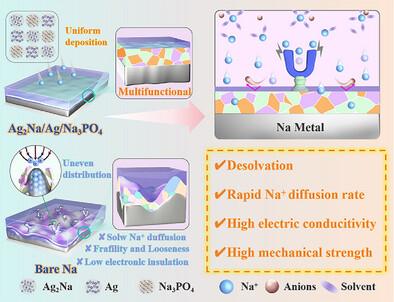工程晶体异质结构界面使无枝晶金属钠阳极具有长期稳定性
IF 26.8
1区 材料科学
Q1 CHEMISTRY, MULTIDISCIPLINARY
引用次数: 0
摘要
钠离子电池(SIBs)的发展关键取决于稳定的金属钠阳极(sma)的发展。然而,由于不可控的枝晶生长和与原始钠金属相关的不均匀的Na剥离/镀行为,实际实施仍然受到阻碍。在这项研究中,设计了一种坚固的三相异质结人工界面,通过Ag3PO4和金属钠之间的自发原位反应形成。由此产生的Ag2Na/Ag/Na3PO4间相协同结合金属相、合金相和离子相,同时调节离子传输并抑制枝晶的形成。具体来说,Ag2Na合金和金属Ag组分确保了很强的界面附着力和增强的电子导电性,而Na3PO4相通过其脱溶能力促进了Na⁺的均相通量,并加速了表面扩散。得益于这种工程界面,Na/Ag3PO4阳极显示出27 mV的超低成核过电位,并在对称电池中在0.5 mA cm - 2 (1 mAh cm - 2)下提供超过1600小时的稳定循环性能。此外,结合Na/Ag3PO4阳极的全钠金属袋状电池实现了425.5 Wh kg−1的高能量密度,强调了该界面设计在下一代高能sib中的实际可行性。本文章由计算机程序翻译,如有差异,请以英文原文为准。

Engineered Crystalline Heterostructure Interphase Enabling Dendrite-Free Sodium Metal Anodes with Long-Term Stability
The advancement of sodium-ion batteries (SIBs) critically depends on the development of stable sodium metal anodes (SMAs). However, practical implementation remains hindered by uncontrollable dendritic growth and uneven Na stripping/plating behavior associated with pristine sodium metal. In this study, the design of a robust triphasic heterojunction artificial interphase is reported, formed via a spontaneous in situ reaction between Ag3PO4 and metallic sodium. The resulting Ag2Na/Ag/Na3PO4 interphase synergistically combines metallic, alloy, and ionic phases to simultaneously regulate ion transport and suppress dendrite formation. Specifically, the Ag2Na alloy and metallic Ag components ensure strong interfacial adhesion and enhanced electronic conductivity, while the Na3PO4 phase promotes homogeneous Na⁺ ion flux and accelerates surface diffusion via its desolvation capability. Benefiting from this engineered interface, the Na/Ag3PO4 anode exhibits a remarkably low nucleation overpotential of 27 mV and delivers stable cycling performance exceeding 1600 h at 0.5 mA cm−2 (1 mAh cm−2) in symmetric cells. Moreover, a full sodium metal pouch cell incorporating the Na/Ag3PO4 anode achieves a high energy density of 425.5 Wh kg−1, underscoring the practical viability of this interfacial design for next-generation high-energy SIBs.
求助全文
通过发布文献求助,成功后即可免费获取论文全文。
去求助
来源期刊

Advanced Materials
工程技术-材料科学:综合
CiteScore
43.00
自引率
4.10%
发文量
2182
审稿时长
2 months
期刊介绍:
Advanced Materials, one of the world's most prestigious journals and the foundation of the Advanced portfolio, is the home of choice for best-in-class materials science for more than 30 years. Following this fast-growing and interdisciplinary field, we are considering and publishing the most important discoveries on any and all materials from materials scientists, chemists, physicists, engineers as well as health and life scientists and bringing you the latest results and trends in modern materials-related research every week.
 求助内容:
求助内容: 应助结果提醒方式:
应助结果提醒方式:


